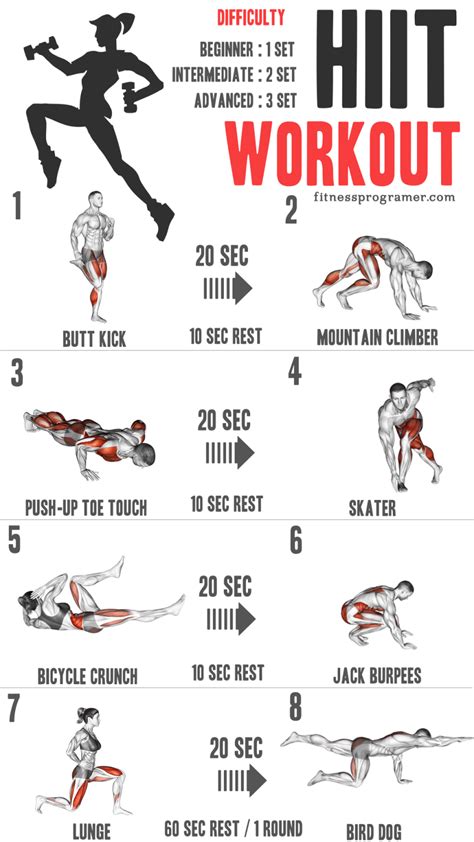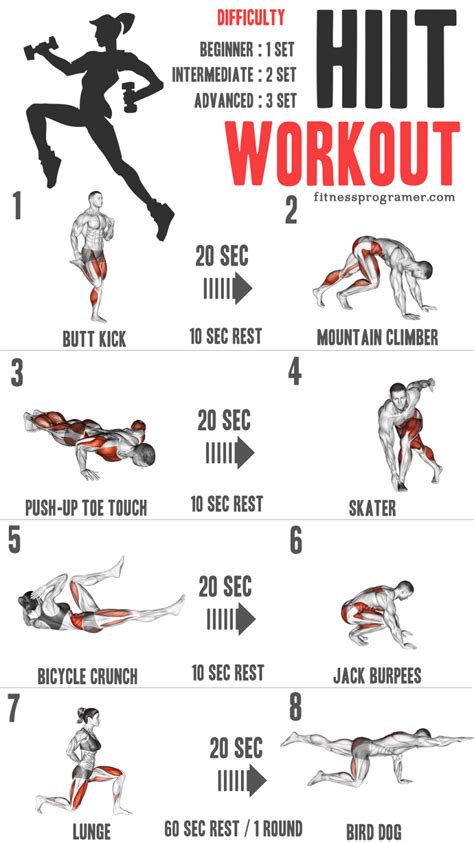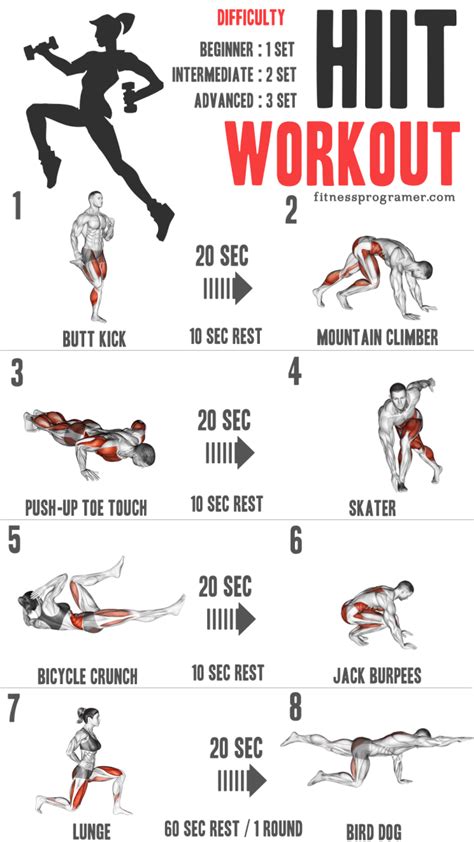Intro
Discover effective HIIT workouts for beginners, incorporating high-intensity interval training, cardio exercises, and strength training for a full-body workout, boosting metabolism and burning fat with short, intense sessions.
High-Intensity Interval Training (HIIT) workouts have become increasingly popular in recent years due to their effectiveness in improving cardiovascular health, increasing calorie burn, and enhancing muscular endurance. As a beginner, it's essential to understand the basics of HIIT workouts and how to incorporate them into your fitness routine. In this article, we'll delve into the world of HIIT workouts, exploring their benefits, types, and providing a comprehensive guide for beginners.
When it comes to working out, many people struggle to find the motivation to spend hours at the gym. HIIT workouts offer a solution to this problem by providing a time-efficient and effective way to improve fitness. By incorporating HIIT workouts into your routine, you can expect to see significant improvements in your overall health and well-being. Whether you're looking to lose weight, increase energy levels, or simply feel more confident, HIIT workouts can help you achieve your goals.
For those new to HIIT workouts, it's essential to start with the basics. HIIT involves short periods of high-intensity exercise followed by brief periods of rest or low-intensity exercise. This cycle is repeated for a specified amount of time, typically ranging from 15 to 30 minutes. The high-intensity intervals can be tailored to suit your fitness level, making HIIT workouts accessible to everyone. As you progress, you can adjust the intensity and duration of the workouts to continue challenging yourself and achieving your goals.
Benefits of HIIT Workouts

Some of the key benefits of HIIT workouts include:
- Improved cardiovascular health
- Increased calorie burn
- Enhanced muscular endurance
- Time-efficient workouts
- Improved insulin sensitivity
- Reduced inflammation
Types of HIIT Workouts

Sample HIIT Workout Routine
A sample HIIT workout routine might include: 1. Warm-up: 5-minute jog or jumping jacks 2. Sprint intervals: 30 seconds of all-out effort, followed by 30 seconds of rest 3. Burpees: 3 sets of 10 reps, with 30 seconds of rest between sets 4. Jump squats: 3 sets of 15 reps, with 30 seconds of rest between sets 5. Mountain climbers: 3 sets of 20 reps, with 30 seconds of rest between sets 6. Cool-down: 5-minute stretch or foam rollingGetting Started with HIIT Workouts

Some additional tips for getting started with HIIT workouts include:
- Find a workout buddy or join a fitness class to stay motivated and accountable.
- Invest in a good pair of workout shoes and comfortable clothing.
- Stay hydrated and fuel your body with a balanced diet.
- Get enough sleep and prioritize recovery to allow your body to adapt to the demands of HIIT workouts.
Common Mistakes to Avoid

By avoiding these common mistakes, you can ensure a safe and effective introduction to HIIT workouts. Remember to start slowly, listen to your body, and prioritize recovery and nutrition to achieve optimal results.
Advanced HIIT Workouts

Some additional examples of advanced HIIT workouts include:
- Pro/Agility shuttle: This involves a shuttle run with a focus on speed and agility.
- Box jumps: This involves jumping onto a box or bench, with a focus on explosive power.
- Kettlebell swings: This involves a full-body exercise that targets the hips, legs, and core.
Conclusion and Next Steps

As you continue on your fitness journey, be sure to stay motivated and accountable by finding a workout buddy or joining a fitness class. Don't be afraid to seek guidance from a qualified fitness professional, and remember to celebrate your progress and achievements along the way.
What is HIIT and how does it work?
+HIIT (High-Intensity Interval Training) involves short periods of high-intensity exercise followed by brief periods of rest or low-intensity exercise. This cycle is repeated for a specified amount of time, typically ranging from 15 to 30 minutes.
What are the benefits of HIIT workouts?
+HIIT workouts offer numerous benefits, including improved cardiovascular health, increased calorie burn, and enhanced muscular endurance. They are also time-efficient and can be modified to suit different fitness levels.
How do I get started with HIIT workouts?
+To get started with HIIT workouts, begin by choosing a type of exercise or routine that suits your fitness level and goals. Start with shorter intervals and gradually increase the duration as you become more comfortable. Remember to warm up properly, listen to your body, and prioritize recovery and nutrition.
What are some common mistakes to avoid when doing HIIT workouts?
+Some common mistakes to avoid when doing HIIT workouts include not warming up properly, starting with too high an intensity or volume, not listening to your body and resting when needed, and not prioritizing recovery and nutrition.
Can I do HIIT workouts at home or do I need to go to the gym?
+You can do HIIT workouts at home or in the gym, depending on your preference and the equipment you have available. Many HIIT workouts can be modified to use bodyweight exercises or minimal equipment, making them accessible to everyone.
We hope this article has provided you with a comprehensive guide to HIIT workouts for beginners. Remember to stay motivated, listen to your body, and prioritize recovery and nutrition to achieve optimal results. If you have any further questions or comments, please don't hesitate to reach out. Share this article with your friends and family to help them get started on their fitness journey, and don't forget to subscribe to our newsletter for more fitness tips and advice.
